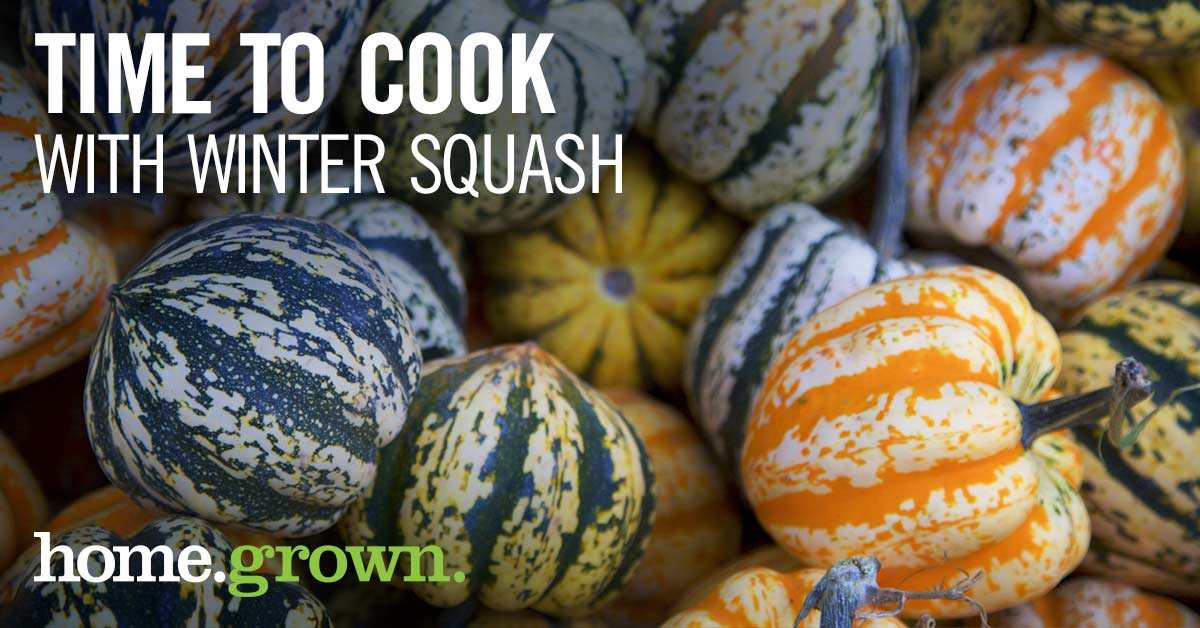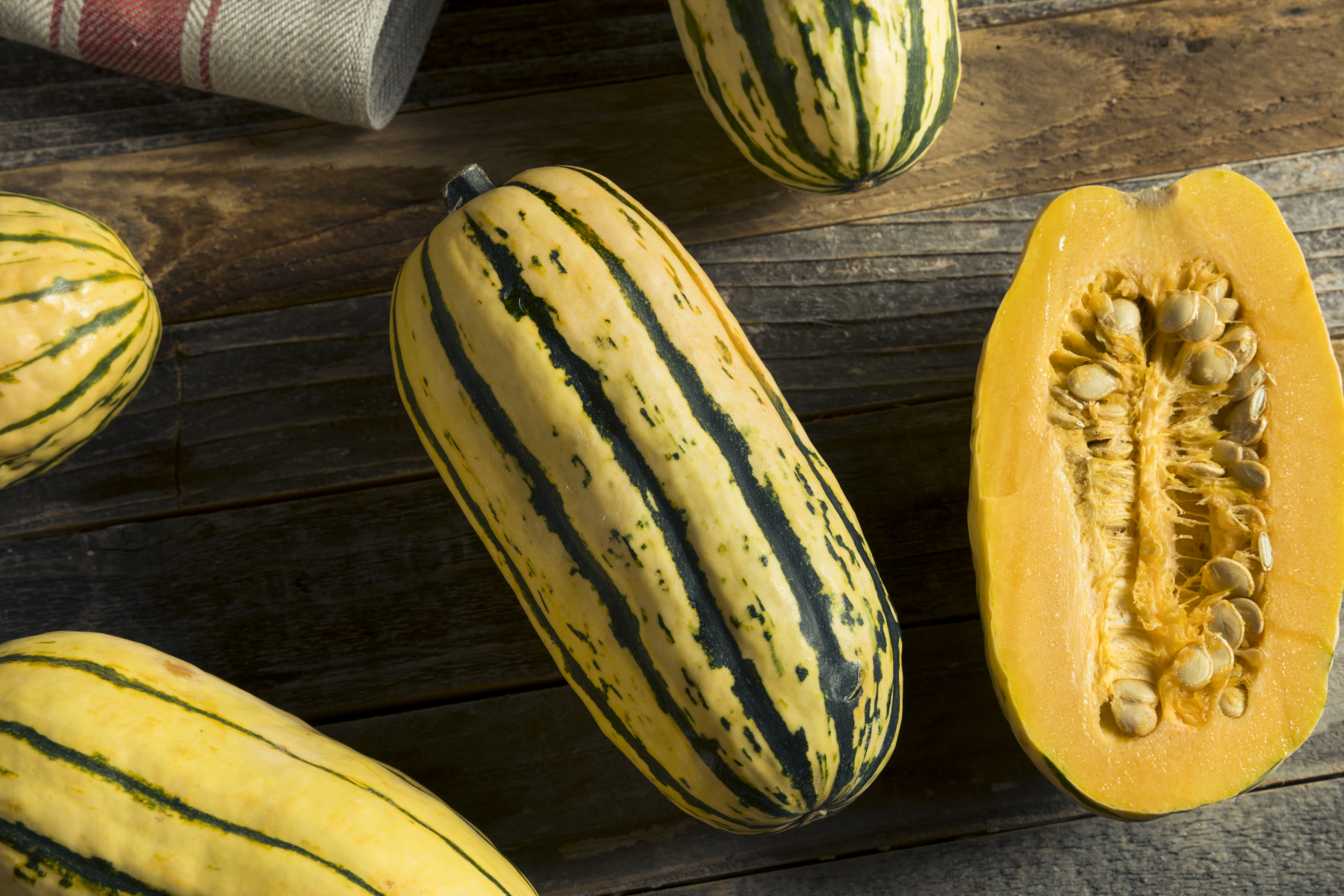The home.grown. Rundown on Some Underdog Winter Squashes

Now that the weather seems like it’s finally cooling off for good: We offer a variety of tasty, local winter squashes that are perfect for your favorite cold weather meals!
November is prime time for winter squashes, and we’re proud to source our hard squashes from farmers here in the Northeast, like Torrey Farms in Elba, NY, Plainville Farm in Hadley, MA, and Mazza Farms in Essex, VT. While many Northeast folks stick with classics like butternut and acorn for cooking and baking, there are a variety of other winter squashes out there that have just as much flavor: we’re here to shed some light on some of those lesser-known winter squashes.
Some decorators use the underdog vegetables below on their front porches and fireplace mantles, but they’re actually delicious relatives to favorites like acorn and butternut. Check out the info below!
Sweet Dumpling Squash (pictured above) is a smaller winter squash averaging 4 inches in diameter and weighing less than one pound. Its shape is similar to that of an acorn squash, with an ivory colored skin and green, yellow, or orange stripes running vertically down the sides. Sweet Dumplings are extra tasty when cut in half, baked and drizzled with home.grown. maple syrup. Also, with their bowl-like shape they’re perfect for stuffing with meat, cheeses, and vegetables.

Raw Organic Delicata Squash Ready to Cook With
is a smaller, underrated squash perfect for the winter. Being smaller than most other squash varieties, they are easy to cut and prepare. They have a sweetness to them that makes them very tasty, you don’t have to add anything. Also, unlike other types of squash, Delicata has a tender, tasty skin perfect for eating, and very convenient for preparing. You can eat them like fries, only they’re a much healthier alternative. In the words of Lloyd Zimmerman of Coxsackie’s Black Horse Farms, “they’re truly underrated!”

Butter Kin fall squash at the farmers market
is a cross between a pie pumpkin and a butternut squash. They have a dark orange interior that is deliciously sweet and smooth in texture. Butterkins can be used to substitute in any dish that calls for butternut squash or cooking pumpkins. For the best preparation, cut the butterkin in half, place face down onto a foil lined baking sheet. Bake in 400F oven until soft. Remove the seeds and discard. Carefully scrape out the softened squash from the cavity and enjoy!

Small blue hubbard squash at the farmers market
was developed in 1953 here in the Northeast by the University of New Hampshire. They have a sweet, yellowish flesh. Luckily, Baby Hubbard Squash is delicious to eat and simple to prepare. Try it roasted, cut into small pieces and tossed with rosemary, olive oil, salt, and pepper. It’s fantastic when served with roasted meats such as turkey, pork, or chicken.
One of the best perks of all winter squashes is the health benefits they provide. They’re a great source of vitamin A and C, potassium, and B vitamins and minerals, including copper and manganese. They’re very versatile and nutritious! No matter which type of squash you select, you can be confident that you’re making a healthy decision. They bring beautiful color and nutrition to your fall harvest meal!
These underdog squashes may be lesser known, but they’re always a tasty addition to any cold weather meal. Between the different varieties there is plenty of selection, and numerous health benefits. This year, take a chance on one of these vegetables: you might just find a new favorite!
 Now that the weather seems like it’s finally cooling off for good: We offer a variety of tasty, local winter squashes that are perfect for your favorite cold weather meals!
November is prime time for winter squashes, and we’re proud to source our hard squashes from farmers here in the Northeast, like Torrey Farms in Elba, NY, Plainville Farm in Hadley, MA, and Mazza Farms in Essex, VT. While many Northeast folks stick with classics like butternut and acorn for cooking and baking, there are a variety of other winter squashes out there that have just as much flavor: we’re here to shed some light on some of those lesser-known winter squashes.
Some decorators use the underdog vegetables below on their front porches and fireplace mantles, but they’re actually delicious relatives to favorites like acorn and butternut. Check out the info below!
Sweet Dumpling Squash (pictured above) is a smaller winter squash averaging 4 inches in diameter and weighing less than one pound. Its shape is similar to that of an acorn squash, with an ivory colored skin and green, yellow, or orange stripes running vertically down the sides. Sweet Dumplings are extra tasty when cut in half, baked and drizzled with home.grown. maple syrup. Also, with their bowl-like shape they’re perfect for stuffing with meat, cheeses, and vegetables.
Now that the weather seems like it’s finally cooling off for good: We offer a variety of tasty, local winter squashes that are perfect for your favorite cold weather meals!
November is prime time for winter squashes, and we’re proud to source our hard squashes from farmers here in the Northeast, like Torrey Farms in Elba, NY, Plainville Farm in Hadley, MA, and Mazza Farms in Essex, VT. While many Northeast folks stick with classics like butternut and acorn for cooking and baking, there are a variety of other winter squashes out there that have just as much flavor: we’re here to shed some light on some of those lesser-known winter squashes.
Some decorators use the underdog vegetables below on their front porches and fireplace mantles, but they’re actually delicious relatives to favorites like acorn and butternut. Check out the info below!
Sweet Dumpling Squash (pictured above) is a smaller winter squash averaging 4 inches in diameter and weighing less than one pound. Its shape is similar to that of an acorn squash, with an ivory colored skin and green, yellow, or orange stripes running vertically down the sides. Sweet Dumplings are extra tasty when cut in half, baked and drizzled with home.grown. maple syrup. Also, with their bowl-like shape they’re perfect for stuffing with meat, cheeses, and vegetables.








